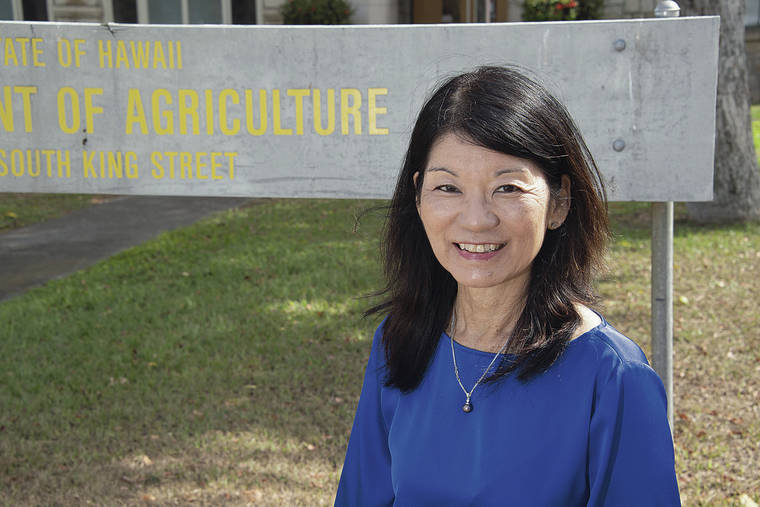Q&A with Phyllis Shimabukuro-Geiser, head of Hawaii Board of Agriculture

CRAIG T. KOJIMA / CKOJIMA@STARADVERTISER.COM
Phyllis Shimabukuro-Geiser, head of the Hawaii Board of Agriculture, hopes to build on the current demand for locally grown food.
What key financial aid programs are helping farmers through disruptions caused by the COVID-19 Opens in a new tabpandemic Opens in a new tab?
In response to the immediate needs of farmers, the Hawaii Department of Agriculture (HDOA) established the COVID-19 Emergency Farmer Relief Program that offered small grants to farmers, ranchers, growers and nonprofit agricultural organizations. In two rounds of funding, the department awarded 202 grants, totaling $470,000, including $20,000 from the Ulupono Foundation.
Though the grant amounts were relatively small, it was especially helpful to farmers who relied on restaurants and the visitor industry by helping tide them over until they could find alternate markets for their commodities.
The department also established an emergency agricultural loan program, which offers low-interest loans of up to $150,000. Micro-loans, which require less paperwork and are processed more quickly, are also available up to $25,000.
Larger grant opportunities may be accessed through the U.S. Department of Agriculture (Coronavirus Food Assistance Program, Farmers to Families Food Box Program), and the U.S. Small Business Administration.
Is there yet any baseline data on local food production? Is progress being made toward food security goals?
Don't miss out on what's happening!
Stay in touch with breaking news, as it happens, conveniently in your email inbox. It's FREE!
The department has some baseline data from 2010 that indicates significant production growth in several commodities, including vegetables and melons, farmed seafood, and, more recently, eggs. Some commodities are showing a doubling of growth since 2010.
Increasing local fresh and processed food production reduces our dependence on mainland and foreign sources of food. Increasing local food self-sufficiency helps to increase our food security. In April 2019, the department began updating its strategic plan to double local food production.
Are there any moves currently to fill the need for facilities, such as cold storage and processing plants?
Currently, there is a strong demand for processing facilities, including cold storage; washing, packaging and milling equipment; dehydrators and freeze-drying machines and other processing apparatus. Food hubs are gaining attention as the entities that can fill this need while allowing farmers to scale up production.
The U.S. Department of Agriculture supports value-added processors with renewable energy and broadband programs. The COVID-19 situation has definitely highlighted the increased demand for these types of agricultural infrastructure.
Hopefully, the current demand indicates the value and will drive private investment into these supportive facilities. One of the main challenges to building processing facilities is the high cost of commercial properties — a reality of doing business in Hawaii.
What is the status of efforts to launch a legal hemp cultivation program here?
The state continues to administrate the Hawaii Industrial Hemp Pilot Research Program. Due to changes in federal law, new state legislation is necessary to comply with updated federal law for the growth of the hemp industry. Unfortunately, the COVID-19 situation has delayed the legislative progress.
To date the program has issued 46 licenses to grow industrial hemp in Hawaii, of which 21 are currently in actual production.
This new industry is experiencing some growing pains. The genetics of the hemp seeds are not stable since the industry is so new, nor are genetics acclimated to Hawaii conditions. Varietals of seeds and the variability of growing conditions affect the crops in different ways, and Hawaii’s high humidity and high wind have led to disease and crop failures.
The market for hemp is also challenging, as a combination of overproduction in 2019 and shifting/unsettled regulations resulted in a crash in the market prices for hemp.
What would help Hawaii build a sustainable ag industry, and develop the workforce for it?
Ideally, returning Hawaii’s farms to economic sustainability would involve greater investment in agricultural infrastructure — including agricultural land; access to irrigation water; efficient packing and processing facilities; state-of-the-art controlled environment agriculture facilities; the assistance of the University of Hawaii Cooperative Extension Service to address food safety, plant pest and disease control, best management practices, and seed development; access to reliable and affordable interisland shipping; and building a strong market for locally grown products.
… Support is also needed for our livestock industry for animal protein production.
Developing a stronger ag workforce includes on-the-farm training programs, affordable worker housing, adequate health-care insurance and other incentives to hire and retain farm workers.
However, the greatest ingredient to sustainability is the Hawaii consumer. If we want our farmers, ranchers and growers to be here for us, we need to support them during hard economic times and just as important, during the good times.
—
THE BIO FILE
>> Title: Chairperson, Hawaii Board of Agriculture since 2019; deputy from 2015-2019
>> Family: Andrew Geiser (husband), Bella (dog)
>> Family business history: A third-generation manager of Mikilua Poultry Farm in Waianae, founded by grandfather in 1947.
>> Education: Bachelor’s degree in animal science from UH-Manoa; master’s degree in avian sciences from University of California, Davis
>> Fun fact: “We woke up at 5:30 a.m., jumped into our boat to followed the Hokule‘a from Maunalua Bay to Waikiki upon her homecoming from her Malama Honua worldwide voyage in 2017. It was a deeply spiritual and awesome experience on the ocean at sunrise observing her return home to Oahu.”
———
Asked by Vicki Viotti, Star-Advertiser



